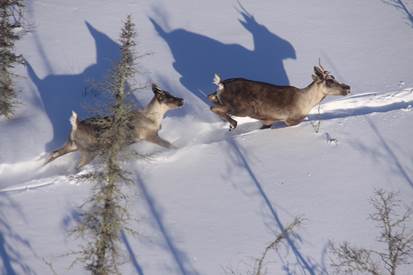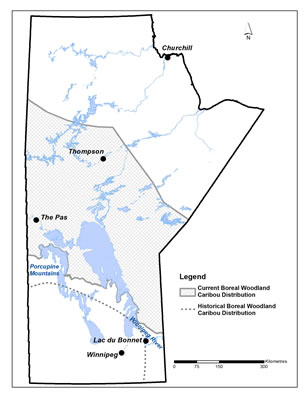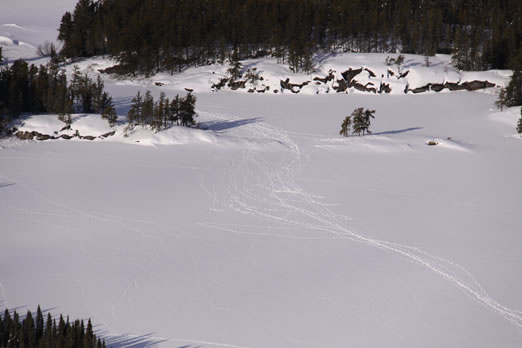Boreal Woodland Caribou
(Rangifer tarandus caribou)
Return to Species and Ecosystems at Risk
Species Status
Provincial Assessment (MESAC):
Endangered—September 1994
Provincial Listing (MESEA):
Threatened—April 2006
Federal Assessment (COSEWIC):
Threatened—2002
Federal Listing (SARA):
Threatened—2003

Description
Appearance
- Boreal caribou coats are typically brownish with a creamy white neck. Boreal caribou are generally darker than the other subspecies and ecotypes.
- Caribou are the only members of the deer family where both males and females grow antlers. Mature bulls typically grow large antlers with cow antlers being shorter and have fewer points.
- Caribou have large crescent-shaped hooves that make walking on snow or bogs easier. The hooves are also used to dig through the snow for lichens and other ground food.
Size
- Boreal caribou are a medium-sized member of the deer family. Boreal caribou are generally bigger than the other subspecies and ecotypes.
- Adult bulls can weigh up to 250 kilograms (550 pounds), but average size is about 180 kilograms (250 pounds).
- Adult cows average about 115 kilograms (250 pounds).
Distribution
- In Manitoba, there are two ecotypes of woodland caribou, that differ mainly by their migration habits:
- Eastern Migratory ecotype (Coastal caribou) - undertake long migrations (200 kilometres) between their forested winter range and coastal summer range.
- Boreal ecotype—may undertake long or short seasonal migrations ranging from 15-100 kilometres, but remain within the boreal forest year-round.
- Boreal caribou occur in a broad geographic area across the boreal forest region of Manitoba.

- Boreal caribou are widely dispersed in the boreal zone from approximately Black Lake area in the southeast to the Lynn Lake area in the northwest.
- The historical southern extent of boreal caribou in Manitoba was to the Manitoba/Minnesota border.
- Boreal caribou no longer occur south of the Winnipeg River in southeastern Manitoba.
- Woodland caribou are migratory, but their movements are not as extensive as those of the barren-ground caribou (Rangifer tarandus groenlandicus).
- Boreal caribou have relatively large home ranges and travel in groups from 1-2 up to 30-40 animals in the winter
Biology/Ecology
Habitat
- Boreal caribou generally inhabit lichen-rich areas of the boreal forest, preferring mature pine, black spruce and tamarack forests intermixed peat land complexes.
- Boreal caribou tend to avoid aspen or other similar broadleaf forest stands and young stands regenerating after logging or fire.
- Large tracts of undisturbed habitat are required for boreal caribou to spread out on the landscape to avoid disturbances and reduce predation.
Food
- Boreal caribou preferred winter foods are lichens that grow in trees and on the ground, found in spruce, pine and tamarack forests. Caribou will crater through the snow to find lichen on the ground.
- During the summer, their diet is more varied. Leafy, soft-tissue plants, poplar, willow leaves, mushrooms, and various forbs are consumed. However, lichen still remains a major part of the diet (25-35 per cent).
- During the winter months, lichen makes up 60-70 per cent of their diet.
Reproduction
- During the fall rut (mid to late October), boreal caribou gather in groups to breed.
- Starting in the spring, mature bulls begin to grow large antlers that they use during the breeding season to defend their group of female caribou from other males. Mature bulls usually drop their antlers during early winter. Younger bulls tend to retain their antlers until late winter.
- Caribou calves are usually born between mid may and late June.
- Female caribou typically have their calves alone and widely dispersed over the summer range. Female caribou will generally drop their antlers just before or just after giving birth.
- Boreal caribou cows do not breed until they are two-and-a-half years old and usually only produces one calf per year.
- Boreal caribou productivity is low compared to other members of the deer family, which breed at a younger age and often produce twins.
Conservation and Management
Threats
Boreal caribou habitat can be threatened by human-caused and natural disturbances such as logging, mining, construction of linear features, recreational activity, fires and forest disease. Linear developments facilitate the movement of predators and increase the potential for human disturbance, which can impact caribou on the landscape. Activities that alter habitat may cause an increase in moose and deer abundance in caribou ranges resulting in increased predation on caribou by wolves.
Wolves are the main predators of boreal caribou, but other predators may include black bears, lynx, wolverines and humans. Caribou avoid predators by spacing out over large landscapes and not bunching up in any one place, making them harder to find. Disturbance to their habitat give predators a hunting advantage and has a negative effect on caribou populations.
Recovery Efforts
Caribou management efforts and monitoring projects have occurred within Manitoba for over 40 years and have been instrumental in survival of the species. These projects have encompassed collaring of caribou, recruitment surveys, distribution surveys and genetic analysis. The intent of these efforts has been to enhance the knowledge base for the species, to generate baseline data for furthering our ability to mitigate development impact and to ensure the species remains as an integral component of Manitoba’s wildlife mosaic.
Manitoba developed a 10-year Boreal Woodland Caribou Recovery Strategy outlines management initiatives and direction for the conservation of boreal caribou across Manitoba. The strategy lays out a new comprehensive, management framework that will help ensure the long-term persistence of boreal caribou in the province.
Manitoba has committed to developing management unit range action plans as part of the province’s caribou recovery planning framework. Range action plans will describe how both federal and provincial strategies will be applied, outlining measures to manage boreal caribou populations, protect habitat and provide for the dynamic habitat requirements of caribou across their range.
By building on existing partnerships with industry, Indigenous governments, non-government organizations and academia the recovery of boreal caribou will be enhanced.



